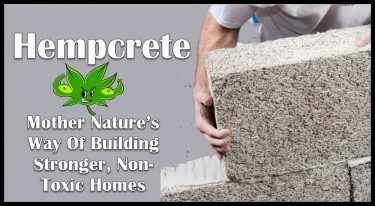Hemp: The Building Material For The Future?

The growth of cannabis and the surge of its products have been mind-blowing the past couple of years. CBD product sales are skyrocketing and analysts say the sales racked up to $6.5 billion in 2020. Large-scale production of hemp which is legal is also increasing and more investors are coming into the industry. This growth has allowed most manufacturers to focus mostly on the use of hemp for cannabinoids while sidelining other uses. One of the uses that have been sidelined is the use of hemp as a building material known as hempcrete.
This article will help you know all there is to know about hempcrete and why it is widely believed to be the building material of the future.
A detailed analysis
Hemp is generally known by all because of the cannabinoids it produces. Sadly this has taken the spotlight away from the other benefits of hemp. The fiber plant has different types of industrial uses such as textiles, bio-plastics, a wood alternative, and a building material called hempcrete. These uses of hemp see the fiber plant in different industries aside from the medical and recreational industries where the use of hemp is familiar.
The name “hempcrete” contrary to what you probably thought doesn’t have much to do with concrete. It is a special material used for walls and insulation in buildings. The material is made by mixing the inner woody core of the stalk known as hemp hurd with a natural lime-based binder and water. Due to the nature of the material, it needs a proper structural framework before it can be fitted into buildings. It cannot also be used in situations where there is constant contact with groundwater.
Hempcrete is by no means a new building material altogether. It has been used in Europe for decades, however, it is just slowly making its way into the US market. In order to promote its growth in the US, there is a need to harness the vast farmlands of cannabis already available.
Steps to promoting hempcrete
Education
For the growth of hempcrete particularly in the US, there is a need for proper education and information. The building material is not one that most are conversant with which means they will need to learn how to work with it. This will require more than books as considerable hands-on experience will also be needed to foster quick understanding. There is also a need to facilitate the training through state and local channels to ensure that all hands are on deck.
Infrastructure
The growth of cannabis has ensured that there is the availability of vast cannabis farmlands. Much of the produce of these farmlands are directed towards the medicinal and recreational use of cannabis. The hurd used to make hempcrete is 65 to 85% of the cannabis plant. The hurd is not useful for extracting cannabinoids which is why it is mostly discarded or used for compost. With the right type of processors on these farmlands, the farmers can easily convert this wasted hurd to make hempcrete
Increased demand
One of the reasons why the growth of hempcrete has stalled is because there is no assurance of demand by end-users. This is why it seems like most farmers are holding back on the opportunity to maximize the product. With the assurance of more demand, farmers can direct more resources into the processing of the materials needed for hempcrete.
Hempcrete is dubbed the building material of the future for a number of reasons.
Resistant to pests and rot
One of the added advantages of hempcrete that makes it perfect for the future is its resistance. Many building materials suffer attract from different pests, mold, or mildew. In no time they lose integrity and affect the overall standard of the building. This advantage gives hempcrete an advantage over other building materials fitted into walls and insulations of buildings.
It is an excellent thermal insulator
Hempcrete is a good choice for walls in homes because it is an excellent thermal insulator. Houses with hempcrete insulations spend less on cooling costs. This also depends on the type of climate available in such places and building design. Hempcrete acts as a thermal envelope in the room and covers all leakages that may pass through seams and layers. Hempcrete has all available organic materials encapsulated which makes it hard to ignite making it resistant to fire.
It is more beneficial to the environment
One of the major reasons why hempcrete has been identified as a beneficial material for the future is its benefit to the environment. Climate change is a major topic on everyone’s mouths right now and a building material that works well in different climates is bound to get attention. Hempcrete is good for a wet climate and it handles humidity very well. It saturates easily and dries out without molding.
Drawbacks of hempcrete
Expensive
One of the major reasons holding back the growth of hempcrete in the building industry is the fact that it is expensive. This is primarily because very few people are actively involved in this aspect of the industry in the US making production and supply channels harder. This is bound to change in the nearest future as more people are seeing the benefits of hempcrete.
It takes time
This is one of the reasons why education on how to handle hempcrete is important. With more knowledge, the issue of time can easily be sorted. However, presently wet hempcrete takes a considerable amount of time to cure which affects productivity. The process is also very labor-intensive. In the hands of inexperienced hands, the issue of time is not the only problem as the integrity of the final product cannot be assured.
Bottom line
The early signs for the use of hempcrete as the building material of the future are very good. With the necessary steps being put in place, most of the present drawbacks can be solved. Once that is done, hempcrete will be used for more buildings in the US and beyond.
HEMPCRETE LEARN MORE...
HEMPCRETE TO BUILD NON-TOXIC HOMES, READ MORE!







